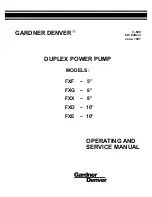
19
4 - PRE-START-UP
4.1 - System cleaning and flushing
Cleaning and flushing the unit and system is the single most
important step to ensure proper start-up and continued efficient
operation of the system.
WARNING: To prevent injury or death due to electrical
shock or contact with moving parts, open unit disconnect
before servicing the unit.
Follow the instructions below to clean and flush the system
properly:
CAUTION: Do not flush system through the unit!
1.
Verify that electrical power to the units is disconnected,
and that the circulation pump is deenergized.
2.
Connect the supply hose directly to the return riser valve.
Use a single length of flexible hose, as shown in Fig. 17.
NOTE: If the length of hose is too short (i.e., the resulting
connection would exceed the minimum bend radius of the
hose), substitute two lengths of flexible hose joined together
with a field-supplied, standard NPT coupling and the flare-
fitting-to-pipe adapters provided with the hose kit (Fig. 17).
Fig. 17 - Temporary connection for flushing system
piping
7.
Open a drain at the lowest point in the system. Adjust the
make-up water replacement rate to equal the rate of bleed.
Continue to bleed the system until the water appears clean
or for at least three hours, whichever is longest; then, com-
pletely drain the system.
8.
Refill the system with clean, chemically treated water.
Since water varies for each locality, contact a local water
treatment company for the correct treatment chemicals to
use in your area. Set the boiler to raise the loop
temperature to approximately 29
°
C.
CAUTION: To avoid possible damage to piping systems con-
structed of plastic piping DO NOT allow loop temperature to
exceed 43
°
C.
Circulate the solution for a minimum of 8 to 24 hours. At
the end of this period, shut off the circulating pump and
drain the solution. Repeat system cleaning as necessary.
9.
When the cleaning process is complete, remove the short-
circuited hoses. Connect the hoses to the proper supply
and return connections on each unit. Refill the system and
bleed off all air.
10. Test the system pH with litmus paper. The system water
should be slightly alkaline (pH 7.5 to 8.5). Add chemicals,
as appropriate, to maintain acidity levels.
CAUTION: DO NOT use “Stop-Leak” or any similar chemical
agent in this system. Addition of these chemicals to the loop
water will foul the system and will inhibit unit operation.
11. When the system is successfully cleaned, flushed, refilled
and bled, check the main system panels, safety cutouts and
alarms. Set the controls to properly maintain loop tempera-
tures.
4.2 - System checkout
When the installation is complete and the system is cleaned and
flushed, follow the System Checkout procedure outlined below.
1.
Voltage: Ensure voltage is within the utilisation range
specifications of the unit compressor and fan motor.
2.
System water temperature: Ensure temperature is within
an acceptable range shown in Table 4. (When conducting
this check, also verify proper heating and cooling set points.)
3.
System water pH: Verify system water is slightly alkaline
(pH = 7.5 to 8.5). Proper pH promotes the longevity of the
hoses and heat exchangers (see Table 5).
4.
Closed-type cooling tower (open tower with heat exchanger):
Check equipment for proper temperature set points and
operation.
5.
Balanced water flow rate to heat pump: Record the inlet
and outlet water temperatures as each heat pump unit is
started. This check will eliminate nuisance unit tripouts
resulting from water velocities that are either too low or
too high; it can also prevent erosive water flow rates.
6.
Standby pump: Verify the standby pump is properly
installed and in operating condition.
7.
System control: To ensure no catastrophic system failures
occur, verify system controls are functioning and the
sequencing is correct.
8.
Freeze protection for water systems: Verify freeze protec-
tion is provided for the outdoor portion of the loop water
system. Inadequate freeze protection leads to expensive
repairs.
1/2” Flexible Hose
Brass Adapter
(1/2” MPT x 1/2”
Male Flare)
Supply Valve
Floor Line
Return Valve
1/2” flexible hose
Supply valve
Floor line
Brass adapter
(1/2” MPT x 1/2”
male flare)
Return valve
Note: Use standard coupling (field-supplied) and hose adapters to join 2 hoses.
3.
Open all air vents. Fill the system with water. Do not allow
system to overflow. Bleed all air from the system. Check
the system for leaks and repair appropriately.
4.
Check and adjust the water and air level in the expansion tank.
5.
Verify all strainers are in place. Start the pumps, and sys-
tematically check each vent to ensure all air is bled from
the system.
6.
Verify make-up water is available. Adjust make-up water
appropriately to replace the air that was bled from the
system. Pressure test and inspect the system for leaks and
make any necessary repairs. Check and adjust the water
and air level in the expansion tank.














































